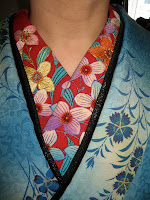




On Saturday I was suddenly invited to go to a special pub, where live tsugaru jamisen can be heard. There is a bit of a history to the place. After the war, in the 1950s people flooded to Tokyo to find work, from poor country areas, especially in the northern part of Japan. These workers all arrived at the Ueno area of Tokyo, and there were hundreds of little bars and restaurants where they could go and hear live music from their home countryside. This little establishment is the only one of these that still survives. Apparently it is popular with sumo wrestlers, many of whom come from this area. There are two sort of folk types of music in Japan. One is enka, which is really nostalgic drinking songs, using conventional Western styled instruments. It has some similarities with country and western music, songs about lost love, drinking too much and so on. It could be considered a sort of early version of pop music. In contrast to this, minyou, is folk music, more similar to the folk songs of Ireland or Scotland, deeply rooted in a place, and played with traditional Japanese instruments. The tsugaru peninsula is in the very north part of Honshu island, and is famous for its harsh climate, and its shamisen players. The area is also where the famous writer, Osamu Dazai came from. It is a wild and beautiful place, far from the bustle of Tokyo, and consequently from the economic advantages found in a big city. I wonder if poverty and folk music have an inverse relationship, as the musical heritage is rich. These young guys and gals were also our waiters at the low flat tables and several of them are winners of the national tsugaru jamisen contests. Interestingly enough two of them come from Kyushu, the other end of Japan!
Their clothing is typical work pants, called momohiki, and happi jackets. These are seen in the country and in festivals throughout Japan. The indigo and white is beautiful in its simplicity and their performance was stunning in its energy. Enjoy!






































